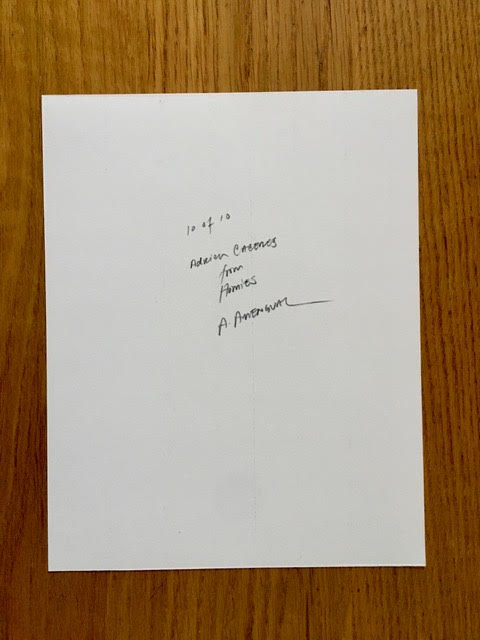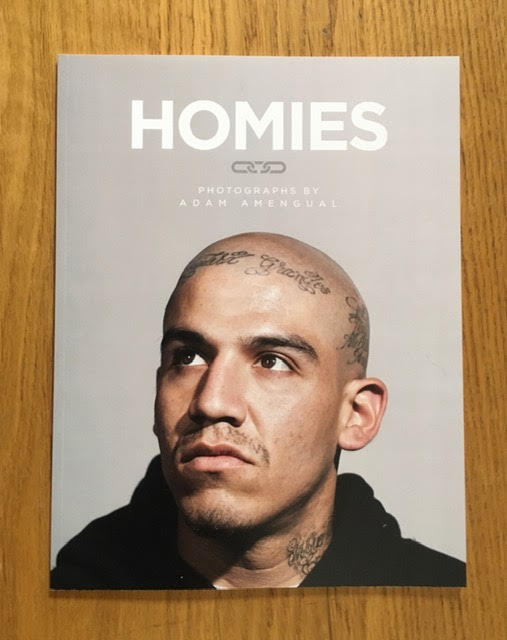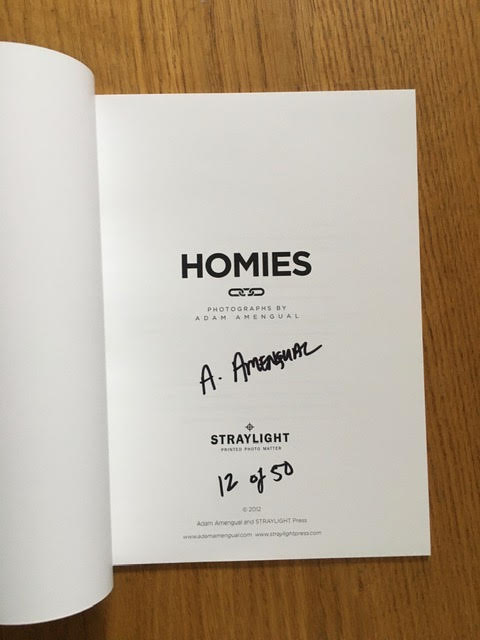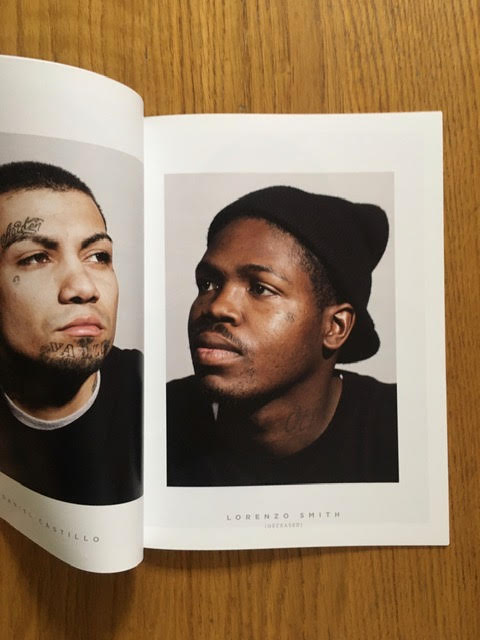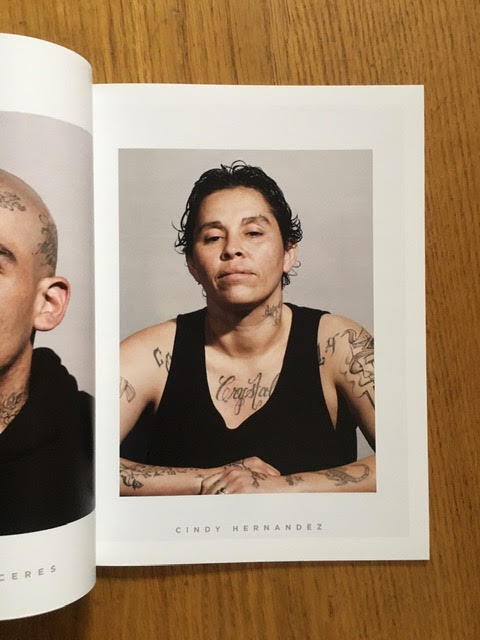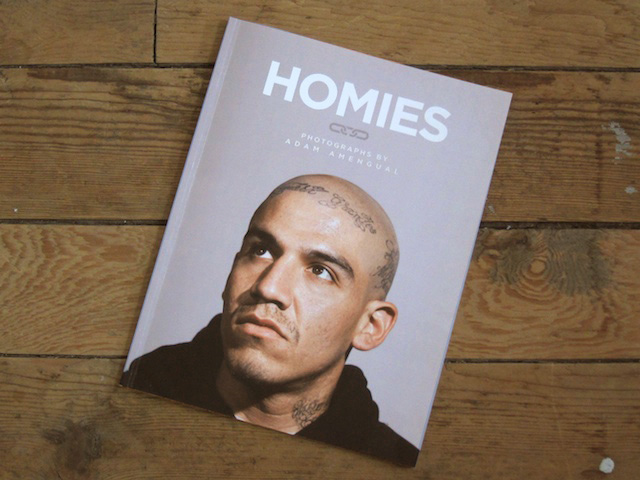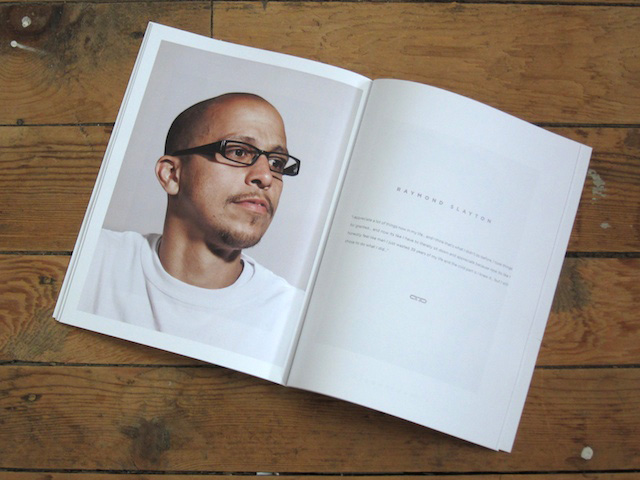SOLD. Limited Edition Signed Photograph & Book by Adam Amengual, Los Angeles, USA
Original Photograph & Softcover Book, both signed & editioned. Photograph measures 8 x 10 inches; titled, signed and edition 10 of 10 (only 10 printsd produced). Booklet produced by STRAYLIGHT Printed Photo Matter 2012. Measures 8.25 x 10.75 inches. Color photos and text within. Signed and edition 12 of 50 (only 50 books produced). Mint condition.
SOLD.
Artist Statement:
I was born in Queens, NY in 1981 and then raised in a small town north of Boston, MA. My father gave me my first camera at 13 and I haven’t stopped taking pictures since. I’ve been based in LA for the last seven years working as a documentary and commercial photographer. I love to tell stories that take shape through the use of a variety of imagery from portraits to landscapes. If I’m not making work for someone else, I’m documenting my adventures in hiking, biking, surfing, camping, and road-tripping.
Awards
-Cover of American Photography 35 in 2019
-The Sony Emerging Photographer Award 2012
-Honorable mention in En Foco’s New Works Photography Awards #15 Fellowship, 2011-12.
-“Homies” featured in the PDN Photo annual 2012 and the American Photography 28 in 2012
INTERVIEWS:

INTRODUCTION
Los Angeles based photographer, Adam Amengual says of his series Homies:
“Through the help of the non profit Homeboy Industries I photographed people who have made the decision to change their lives for the better. The people in these images are current or former gang members and most had spent time incarcerated before walking through the doors at Homeboy Industries. Through a variety of services, Homeboy Industries helps these men and women redirect their lives and provide them with hope for their futures.”
Homies is very striking; the unorthodox subjects under studio lighting both captures and confuses the imagination when reading the portraits. Not surprisingly, Homies has done the rounds recently, appearing on Wesley, Kate and Joerg‘s blogs. I wanted to find out more about the community at Homeboy Industries, about Adam’s decision-making and about his reception at Homeboy when he turned up with his gear.
CONVERSATION
Prison Photography: Were you invited along to Homeboy Industries or did you approach them?
Adam Amengual: I approached them. The subjects are a mix of employees, active and non-active gang members who are seeking one of the many services that Homeboy provides.
I heard a story on NPR about Rev. Greg [Boyle] and Homeboy Industries, which sparked my interest to explore the story photographically. It was a six month process, stemming from my initial contact, to the shoot, and then finally the follow up interviews.
PP: Why were you motivated to make this series?
AA: I have been interested in gangs and cults for a long time. I am very interested in why people join these kinds of groups. Simply put, they are looking for love and a sense of family. Gangs, for example, take advantage of people who have emotional needs that were not fulfilled at home. That is not the case with every single person that joins a gang, but definitely the majority.
Tim Hetherington talked about how his documentary pictures came from a place of personal curiosity. It was a way to locate himself in the world. I relate to that. I use photography as an excuse to meet people or to answer questions that I am interested in. Homeboy turned out to be a venue for me to fulfill my interests in gangs through pictures. Additionally, the current and former gang members have a very distinct looks; I knew it would make for a visually interesting project.
I’m very interested in how people can break a family’s misfortune or shake an inherited “curse” such as addiction, racism, or gang affiliation. It’s very easy for children to repeat a parent’s mistakes. It takes so much effort, courage, and persistence to take a stand and say, this will not happen to my children. After interviewing a few of the people in my pictures I came to understand that the majority of them are trying to be a better example for their kids.


PP: Describe the reputation of Homeboy Industries in Los Angeles and how it relates to the particular gang culture and the cycles of crime that exist in LA. I’m asking what the public know and think of this type of program. Are they supportive/proud? Do they care?
AA: Unfortunately, I do not think that most Angelenos are all too aware of Homeboy Industries and the great work that they are doing. I often have to explain what the organization is when I am talking about my project. But, I will say that most people are very interested when I explain how the organization works and what it’s all about. So, that is certainly a very good thing.
As for the people that have heard of Homeboy, they are very supportive, but usually they just think it’s a place for job training. People are pretty blown away when I list all the classes, counseling, tattoo removal provided by Homeboy. Don’t get me wrong, job training is a huge part of what they do there and it makes the biggest difference, but all the other services in combination with the job training make Homeboy very effective.
PP: Is Homeboy Industries distinctly Angeleno?
AA: Homeboy Industries is distinctly Angeleno. You hear that right out of the mouths of the people who work there, as well as from those that use their services. People travel from all over the country and the world to study what Rev. Greg has created. Time and time again you will hear people say that there is only one Homeboy Industries. They don’t mean “we’re better than you”, they’re just speaking to the fact that it is such an incredibly unique place.
PP: Your work was recommended to me by your former instructor Stephen Tourlentes. I have featured his work on Prison Photographybefore. Tell us about your education, your philosophy and what you think are the responsibilities of photographers.
AA: I really appreciate Steve sending you my work. I was a teaching assistant for his lighting class. I studied fine art photography at Mass Art in Boston.
I did not plan on studying fine art photography specifically, but I fell into it; I actually rebelled against it for a number of years. Even while I was in school, I wanted to be a commercial photographer, and at that time I had it in my head that Mass Art was cheating me out of something that other more commercial programs were offering.
Little did I know that the ideas professors Stephen Tourlentes, Nickolas Nixon, Abelardo Morell, and Laura McPhee were instilling in me would mold me into the artist and photographer that I am and continually strive to be.
At Mass Art I was schooled in what it meant to be a visual artist and that makes more sense to me now than it ever did before. It’s like the lessons your parents teach you when you’re a kid that you totally don’t get at the time.
Photography is a like trade in a lot of ways; a metal worker can just make guide-rails for stairs or she can be a sculptor. Both take a lot of talent and training, but they are very different mindsets. I’ve learned a lot over the last seven years by assisting commercial photographers – great technical skills, work ethic, and business sense, but all of that, in a sense, I got paid to learn. My professors at Mass Art taught me a way of thinking that’s a lot harder to learn outside of an academic setting. Unless you have an amazing circle of artist friends that are constantly talking about your work and its’ context to the world, you will have a hard time seeing your work from a fine art point of view. I’m not sure if I always had that in me, or if a seed was planted and it took a bit of schooling and time to mature, but I see myself as an artist first and a photographer second.
Photography is very important as a document, a reference for viewers to understand the past and people & places that they’ll not interact with in person.
As for the responsibilities of photographers, that is a hard one. I know what I feel to be my responsibility, especially with my personal work, and that is to make honest pictures. I have a lot of friends in both the fine art world and the commercial side of photography, and I like that. I enjoy discussing the strengths and weaknesses of both worlds, but commercial photography (advertising and editorial) tends to not ask as many questions.
You can compare the world of cinema to the world of photography. There is documentary film-making like Restrepo, moving narratives like in The Kings Speech, or popcorn-mindless-fun like Transformers. There’s a lot of variety and they’re all entertaining on some level. It really depends on the viewer to make the choice on what they want to consume because if there is an audience someone will produce for it.


PP: You’ve said that in the future you would like to photograph juveniles sentenced to life without parole (LWOP). Why this particular group?
AA: Juvenile lifers are a group that I am really drawn to “putting a face on”. A lot of times you hear statistics, particularly ones that relate to the prison system, and it upsets people or makes them feel like something is wrong. But, truthfully, those statistics are just a bunch of words and numbers. When you actually see a person that is affected by the system, then the meanings within the issue make lasting and meaningful impressions.
I had heard some statistics about LWOP juveniles and asked who are these kids? What is their story?
I saw a documentary When Kids get Life on PBS, it was informative but it only covered a few stories in Colorado. Many other states impose this sentence, and I would like to show more broadly who these people and families are. One of the men I photographed and interviewed for Homies was sentenced to life at 17. He spent 27 years behind bars. Why did he end up there? The easy answer is a violent crime, but the harder question to answer is why did he commit that crime in first place? I’m sure that if you took a look at 50 people serving time in prison you could find a lot of similarities in their formative years.
Furthermore, the idea of youth in our culture, what most people envision as the best years of your life, is the opposite of being stuck in prison. I think this is an idea that could be understood in a visual manner and could make a strong point when looking at a portrait of someone in that position.
PP: What are your general thoughts on the prison systems in the US – from your own perspective and also the perspectives of those you’ve photographed.
AA: Prisons are an example of what American culture does best, we look for the quick and easy way to “fix” anything. Get fat, get plastic surgery, something you bought breaks, throw it out. We have a hard time looking at the source of problems and want to just sweep many away.
I am currently reading Gabor Mate’s book In the Realm of Hungry Ghosts. Gabor talks about how at one point it was thought that genes made you a drug addict and this was accepted so quickly because as a society we want to say that a person was messed up from the get go, had no chance, that there was nothing we could do. As it turns out, genes have only the slightest effect on how a person develops negative issues in life. How a person is raised and early life experiences is what really determines the kind of functioning role they will have in society. Treating society with preventative medicine, to make sure people do not commit crimes, join gangs, etc. is a lot harder to do.
Almost every person I talked to at Homeboy, that had done any kind of serious time, said that prison just makes you an even worse criminal. To quote one of my subjects, “You go in there with the weed problem you come out strung out on dope…” Another thing that I was told is that the longer you are in there, the more you have to adapt to being in prison and learn to survive. Then you have to re-adapt to “normal society” once released. If you do not re-adapt and most do not, that prison mentality will cause you to end up right back in there.

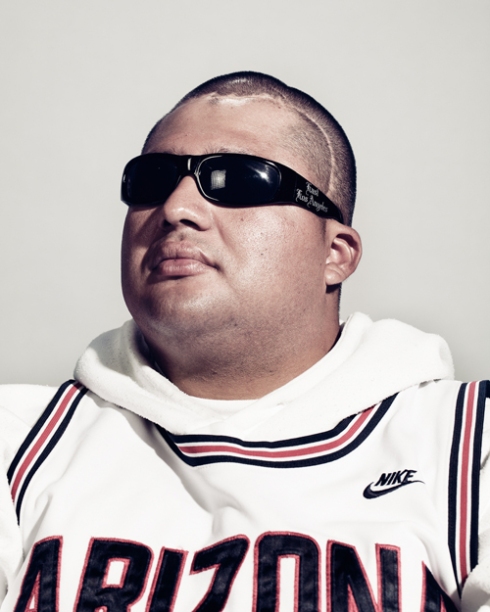
PP: I don’t usually ask about techniques or lighting (I am not a photographer), but your Homies portraits have a particular look. Explain your choices in setting up the portraits.
AA: A few of my biggest influences in photography are Thomas Struth, Rineke Dijkstra, and Stefan Ruiz. All three have worked in the portrait style that I chose for this series. Studio portraits satisifed both logistic and aesthetic concerns.
When I first approached Homeboy Industries, I wanted to photograph a subjects in their home environment, but it was made fairly clear from the start that I would not be able to do that. I was told that if I was more than welcome to shoot on Homeboy’s premises. I knew I did not want the Homeboy facility to overpower the individuals I was making portraits of, and to do that I needed to visually remove the environment.
When shooting a studio style portrait I sometimes like to use a bit more of a hyper-real light source, nothing over the top, but a light that has a physically descriptive character to it. It cannot be too distracting. I don’t want the viewer paying more attention to the lighting than the actual subject.
For three reasons, I wanted these pictures to be a tighter crop. One, I have always been really into Flemish Portrait paintings from the 17th century. The lighting and chest up crop was, in my opinion perfected by painters like Van Dyke. Two, I wanted to focus on the face as well as the hands; tattoo culture is such a big part of their appearance that I really wanted to show those details. Three, shooting in this style begs a comparison to a mug shot. A majority, if not everyone in this series has had a mug shot taken of them at one time in their past. I feel I have flipped that old image of them showing them as proud and iconic. It is a visual metaphor for the transformation they are bringing to their own lives.
PP: Did you give your subjects direction? What did they want to convey through your photographs.
AA: I gave them only a few cues. Everyone that I photographed were all proud to be at Homeboy and proud of why they were there. They know that they are taking steps in the right direction, and I really wanted to capture that. I mentioned old painted portraits, pride and stoicism, to make sure they got the idea that I wasn’t looking to make a smiley Sears portrait. I photographed them digitally so I was able to show them exactly how their pictures were going to look and feel. I think this really helped with the collaboration.
When first photographing someone there is always a trust to be gained, this can take anywhere from a few seconds to an hour, even more sometimes. After the first few people at Homeboy saw how the images were going to look, more and more people then wanted to be photographed. I believe they felt it was a chance to document and celebrate this positive action in their lives. It was an incredible experience to be a part of.
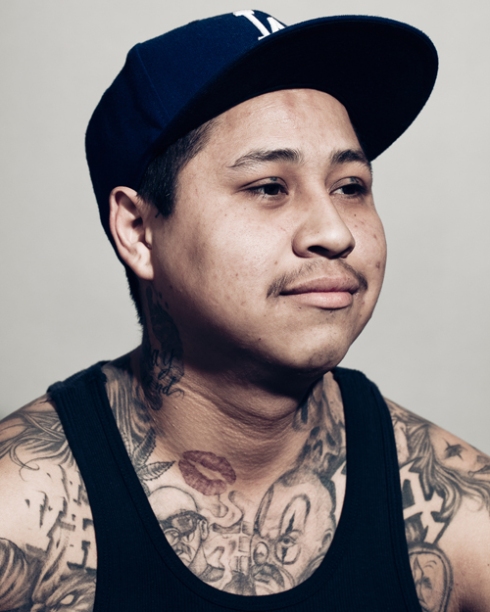
Adam’s website
ADAM AMENGUAL
drool has a short blog roll. Now, some bloggers will link indiscriminately
to aid their Google ranking. Others have compiled large lists of blogs
because they like a lot of blogs.
I have to admit that I only regularly read 6 or 8 fotoblogs and it’s been
over a year since I added one to drool’s list of links. And that would be
Los Angeles fotografer Adam Amengual’s Wandering Wayfarer.
The first I heard of Adam was when I saw his new series of portraits:
HOMIES. Struck, I headed over to check out his online presence. I was
struck again.
Adam shoots for money, but he also shoots for the love of it. His web
site holds aspects of both these pursuits and his blog is a swell mix
what he’s up to now, some side projects in progress and so on.
There’s lots I could ask him but I want to stick with the HOMIES…..

Edward Mejia
drool: Adam, tell me a little about the genesis of this project. Why you
were interested, how you made contact, the hoops you had to jump
through to make it happen.
A.A.: I’ve been attracted to two stories for quite a long time. One is
the story of why people join gangs, cults, hardcore religious factions,
etc. The other is the story of positive change, how a human can go
from living a negative existence to a productive one.
I had several other projects that I was researching when I happened
to hear about Homeboy Industries on NPR (National Public Radio). I
had passed their building several times after moving to LA but I never
knew what it was or paid much attention to it. Both my wife and I were
listening to NPR and Kate says to me, “hey that’s that building next to
China town.” The story of Homeboy Industries, as a gang intervention
center sparked my interest instantly. So just like several other projects
I was researching, I cold emailed Homeboy Industries, but unlike the
other potential projects Homeboy got right back to me after one email.
I have to say that it was very cool of them to trust me right away. I hadn’t
photographed a project similar to this subject before and my current web
site had only pictures that were singles and one off portraits, no projects.
So I had to just describe my idea to my contact there and hope for the best.
Homeboy is a place that takes people in and sees the potential in them
when others do not, I could not have picked a better place to do my first
project like this. They were open to working with me from the beginning,
which was awesome and a good confidence boost for me. It took about 6
months after that initial contact to actually setup when to shoot, but still,
after our initial emails I knew something was going to happen at some point.

Jose Ruiz
My good friend and fellow photographer Dylan Vitone (dylanvitone.com) has
worked in documentary photography for his entire career. He has been a
mentor and friend for about 10 years and has seen the direction of my
photography change a lot in that time. I had talked with him a lot about
shooting more project based work and not just shooting editorial port-
raiture. I think one of the best pieces of advice he had given me was
that you never know where a project will take you or how it will work
out, the most important thing is just to shoot it and let it take on it’s
own momentum and direction.
When I first contacted Homeboy I wanted to find a few people that would
allow me to start making documentary portraits in their home and/or out
in their own environment. After my first few email with my administrative
contacts there I realized that shooting out side of Homeboy wasn’t going
to happen immediately and that I would have to initially shoot on the org-
anization’s physical grounds. I then decided to do a “portrait day” where
anyone interested could come and sit for a “studio” portrait. This worked
out fantastic and really helped the project come together conceptually. I
love both environmental portraiture and studio portraiture. There are
strengths and weaknesses to both in how they tell a person’s story. For
“Homies”, I feel the studio style works because you get to concentrate
on the subjects and get to compare their similarities and differences with-
out distraction of the place that surrounds them.
Also, the shot begs the comparison to a mug shot of sorts but a beautiful
one. Almost all of these people have been arrested and have had a mug
shot taken of them. I feel like I have flipped that idea and made a more
beautiful version of an ugly picture from their past. Just like what the
subjects themselves are doing with their own lives. They’re taking what
they once were and making themselves better.
So after setting up my initial tour, emailing back and forth a dozen or
so times, I finally was able to setup a shoot day. I knew I could have
shot it a lot simpler, with a lot less gear but I decided to push that a
bit and created a black box studio in the lobby of the Homeboy Ind-
ustries building. I brought two assistants with me as well. I photo-
graphed 50 people that day.
Looking back, there were many factors that came together to make
this happen which molded the project in both look/feel and concept.
I took Dylan’s advice, and let it take its own path. I am hoping to have
a few spin off projects based around individuals whom I am following
up with. I have also gone back to interview some people to add some
quotes.

Cindy Hernandez
drool: Okay. Wow. Lots of information. I’m asking this next question
because it’s something that comes up with USER. Do you think people
relate/react to your HOMIES fotos in a specific way because of who/what
the subjects are? Does this matter to you?
A.A.: Yes and Yes. I think that people relate/react to my subjects in
this series in a few specific ways. For one, gang culture is one of
those things in America that is oddly glorified, especially since the
90’s with the popularity of gangster rap. So there is the curiosity
of those that glorify that lifestyle. And then, unfortunately, I am
sure that there are also some that look at the people in Homies,
especially the ones that are heavily tattooed, that are curious
about them on some kind of freak show level. I am more annoyed
by this person than the person who glorifies gang life, but that kind
of viewer is generally unavoidable. Another type of person that
seems to be drawn to these pictures are lovers of tattoo culture. I
personally have been very interested in the ways tattoos have been
used around the world, whether its tribal, criminal, decorative, etc.,
so I can see this connection as well.

Jerry Montaque
What I hope for the most, and what I’m trying to achieve is for people
to look at the Homies and see another human being, that they take a
minute/30 seconds to try to empathize with the person they are look-
ing at. My goal with portraiture like this is to have people connect with
another person on some kind of level. Although it may never be as real
as a physical, person to person interaction, I still think you can have some
kind of relation to a person through a picture. Many people would be far
less inclined to initially connect person to person with a subject like one
of the Homies because of the intimidation factor. I think it’s important
that portraits are made of something other than a celebrity or some other
demigod of modern culture that we “strive” to relate to. We see hundreds
of portraits everyday in magazines and billboards that people stare at and
wish they were as cool, beautiful, rich, etc… as. I hope when people look
at the Homies series or anything similar, that they connect on a more
human level, that they understand a piece of that person and gain a
respect for them. It is important to me that my subjects are represented
as proud and always shown in a respectful manner, even if they may be
at a tough spot in life.

Adrian Caceres
drool: Thanks Adam, is there anything you’d like to add?
A.A.: I would just like to thank everyone who helped make this project
happen, Rebecca, Norma and Marissa at Homeboy Industries. Aly and
Mark at Milk Studios and David at OTMFC, John DuBois, Lauren Lemons
and my wife Kate, without her support of me as an artist and photographer
I don’t think I could put the time and effort into making this kind of work. If
you like my Homies series please take a second and donate to Homeboy Ind-
ustries, you can find out more about them here: Homeboy Industries. And
Thank you to you Tony! I really appreciate your interest in the project.
You will find more of Adam’s work here.
e-photo review just did a thing on Adam, too. See it here.

HYPO
a newsletter / tony fouhse

